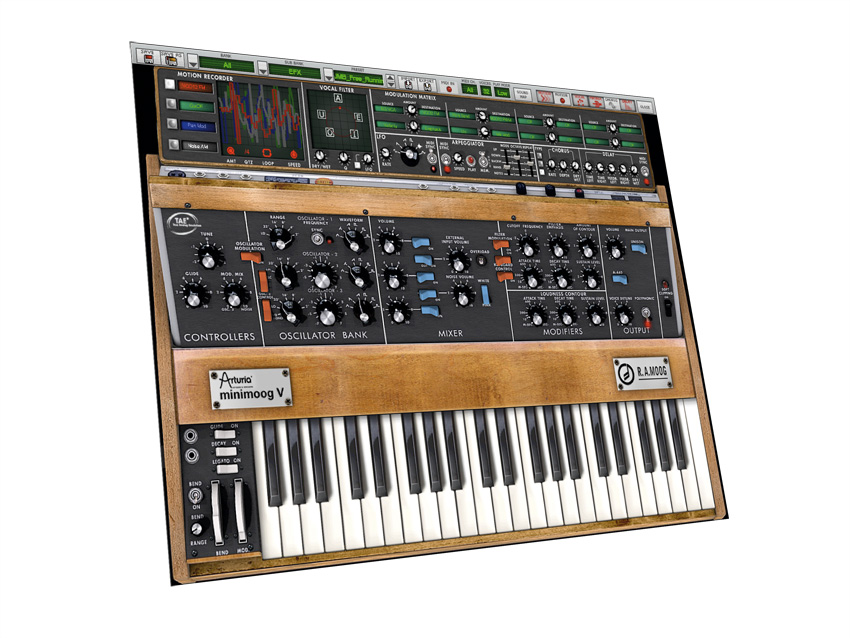MusicRadar Verdict
A radical and effective revamp of a classic studio stalwart.
Pros
- +
'Motion' options galore for liquid sound design. Vocal Filter. Sound Map – preset browsing has never been such fun!
Cons
- -
Purists might not like it.
MusicRadar's got your back
We wouldn't be flattering Arturia too much to suggest that, when it comes to software recreations of some of electronic music's most celebrated synthesizer technology, it's up there with the best.
One of the company's best loved titles - the Minimoog V - has just been treated to a Version 2 update - an interesting challenge requiring a balance between respecting the tradition of the most famous synthesizer ever made and giving it a 21st century twist.
What's new?
Arturia's original Minimoog V set about trying to recreate the sound of the famous Moog hardware and as this hasn't changed (obviously!) nor has the main part of the Minimoog V GUI.
However, if you click either the upper edge of the synth's display or the Open button in the top right hand corner, hey presto, the upper section of the synth falls forwards to reveal Arturia's pimped up 'extras rack'.
There are several new highlights here. Firstly, there's a Motion Recorder in the top left hand corner, which enables you to choose four colour-coded parameters and draw envelopes for these, which can create dynamic change in a sound as it plays. You can sync these envelopes to tempo, loop them and set their speeds, so wild and crazy moves are absolutely possible now.
There's also a vocal filter which applies vowel formants to any sound. The Minimoog filter is famous, of course, but Arturia hasn't been afraid to offer this timbral alternative, which, if you'll excuse the pun, speaks for itself the moment you push a sound towards any of the five vowel targets on offer.
Next comes a revised modulation matrix, which is where you can set eight sources and destinations with independent amounts available to each of these routings. The new filter and extra new options like twin sample and hold triggers are available as sources so, again, the options for sound design are vastly increased. There are even additional coding developments too to modify the circuit modelling.
However, our favourite new feature has nothing to do with the sound engine at all but the way in which Arturia has presented a new approach to preset browsing.
The Sound Map comprises a window with all presets mapped like a constellation of satellites with similar sounding timbres occupying neighbouring portions of the display. You can click on a preset to audition it or select a nearby sound to hear a related variation.
The further you travel the more the sound changes and it's even possible to morph from one sound to another. You can filter your search to maximise the chance of finding something you're after or just dive in at random. The window looks like a night sky without cloud cover - beautifully designed and extremely effective.
Summary
If the purists come down on Minimoog V2 for altering a classic, they've missed the point. This remains a great sounding Moog clone but it now has both feet planted firmly in the present and offers enough to satisfy you in the future. If you're after a pimped up Moog in software form, be here now.
Listen to the Minimoog V2's classic sound:
Future Music is the number one magazine for today's producers. Packed with technique and technology we'll help you make great new music. All-access artist interviews, in-depth gear reviews, essential production tutorials and much more. Every marvellous monthly edition features reliable reviews of the latest and greatest hardware and software technology and techniques, unparalleled advice, in-depth interviews, sensational free samples and so much more to improve the experience and outcome of your music-making.
“A well spec’d device that bridges the gap between a basic stereo field recorder and a more advanced multitrack device”: Zoom H4 Essential review
Learn production, DJing and songwriting from pros like Fraser T Smith, Carl Cox, Skream and Joe Goddard with Whatclass
Native Instruments’ Kontrol S MK3 MIDI keyboards just added several features that DAWless music producers have been asking for











